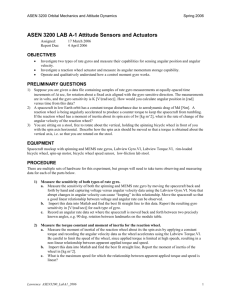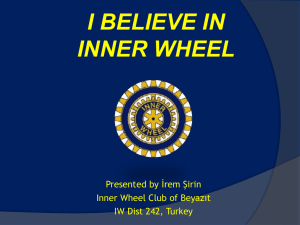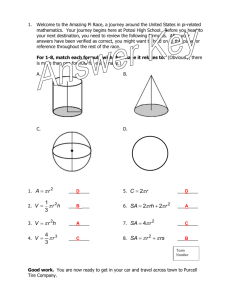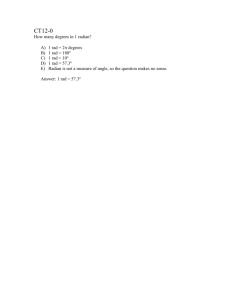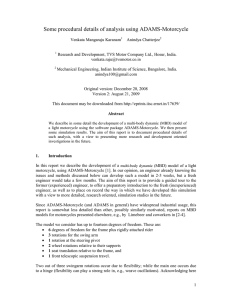11 JULY 2014 4 BALL GYRO POWERPOINT (4)gallix
advertisement
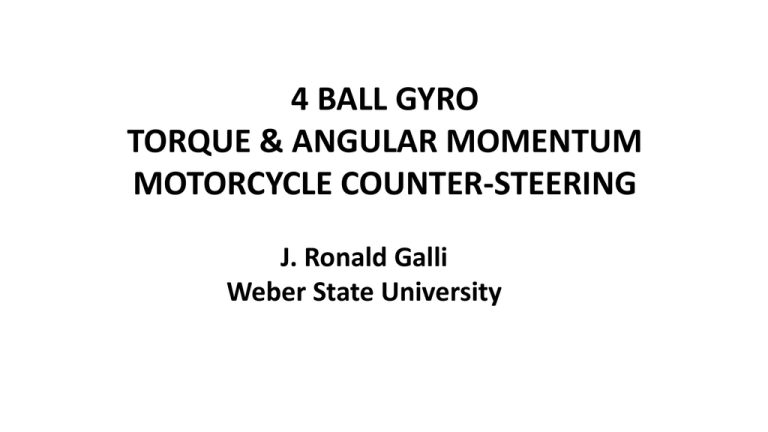
4 BALL GYRO TORQUE & ANGULAR MOMENTUM MOTORCYCLE COUNTER-STEERING J. Ronald Galli Weber State University 4 BALL GYRO – SIMPLE EXPLANATION PUSH 2 3 1 4 PULL • The masses behave as a spinning wheel with initial motion as shown, in the xy plane. • Next, the left hand pushes out away from the body (x direction) and the right hand pulls back toward the body. • Ball 1 is forced down as it moves left, toward the vertical yz plane. • This forces the left grip to move left and downward. • Similarly, the right grip is forced to move right and upward as ball 3 is forced up while moving right, toward the vertical yz plane. Z Y X • Thus an initial torque about the y axis causes a twist about the x axis. MOTORCYCLE TURN – SIMPLE EXPLANATION • Think of the front wheel of a motorcycle as consisting of 4 heavy balls attached to 4 strong “massless” rods and rolling, as shown, on a smooth “massless” rim. • Ball 1 spins to the top position while being forced to the left (negative x direction) by a push forward on the left handlebar, or a pull backward on the right handlebar. Z Y X CONCLUSION: Pushing forward on the left grip or pulling back on the right grip will cause the two wheel motorcycle, at highway speeds, to turn TO THE LEFT! WOW!! • This causes the wheel and the motorcycle to tilt downward to the left. • Now that the wheel and motorcycle are leaning to the left, a gravitation torque will turn the wheel to make a left turn. • This is like hanging the wheel (or 4 Ball Gyro) from a rope at the end of the right grip. 4 BALL GYRO • • • • • Copper pipe construction on bicycle axle hub Four arms, each 10 inches long Four balls – copper cups, each filled with one pound of lead Steel handles Total weight 7 pounds MOMENTS OF INERTIA 4 BALL GYRO WHEEL RADIUS R z M M R M z y y M x 4M SPECIAL POSITIONS ON X AND Y AXES Iz = 4MR² M y₂ Ix = Iy = 2MR² y M R x₂ M x y₁ x x₁ M Iz = 4MR² Iz = Ix + Iy Ix = Iy = Iz⁄2 = 2MR² Thus the Moments of Inertia about the three principal axes are essentially the same for the 4 ball gyro as for the wheel of the same rim mass and radius. Therefore the equation τ = Iα will give the same dynamical result for the same torque applied under the same conditions. GENERAL POSITIONS - 90 degree separation Ix = 2My₁² + 2My₂² y₂ = x₁ Ix = 2M(x₁² + y₁²) = 2MR² Ix = Iy = 2MR² Iz = 4MR² z is out of page This would also be the same for a wheel with 4 additional masses attached to the rim. However Ix, Iy, and Iz would then each be increased accordingly (doubled for example, if all masses are as given herein). FURTHER NOTES Two Kinds of Force • Force of propulsion (forward or backward) – along the line of motion (motion speeds up or slows down) • Force of deflection for moving object – perpendicular to motion. Changes direction of motion. Two Kinds of Torque (Twisting Force) • Torque of propulsion (forward or backward) – in the direction of spin (rotation speeds up or slows down) • Torque of deflection for spinning object – perpendicular to spin axis. Changes direction of spin axis. REFERENCES 1. Ernest F. Barker, “Elementary Analysis of the Gyroscope”, Am. J. Phys. 28, 808-810 (1960) 2. Harvey Kaplan and Andrew Hirsch, “Gyroscopic Motion: Show Me the Forces!” Phys. Teach. 52, 30-33 (2014) 3. A demonstration wheel with 4 masses added is available from www.pasco.com

